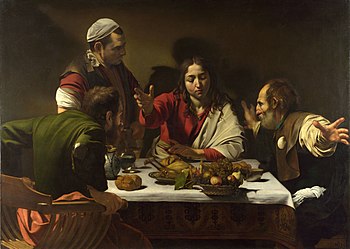art.wikisort.org - Painting
The Supper at Emmaus is a painting by the Italian Baroque master Caravaggio, executed in 1601, and now in London. Originally this painting was commissioned and paid for by Ciriaco Mattei, brother of cardinal Girolamo Mattei.
| Supper at Emmaus | |
|---|---|
 | |
| Artist | Caravaggio |
| Year | 1601 |
| Medium | Oil on canvas |
| Dimensions | 141 cm × 196.2 cm (56 in × 77.2 in) |
| Location | National Gallery, London |
The painting depicts the moment when the resurrected but incognito Jesus reveals himself to two of his disciples (presumed to be Luke and Cleopas) in the town of Emmaus, only to soon vanish from their sight (Gospel of Luke 24: 30–31). Cleopas wears the scallop shell of a pilgrim. The other apostle wears torn clothes. Cleopas gesticulates in a perspectively-challenging extension of arms in and out of the frame of reference. The standing groom, forehead smooth and face in darkness, appears oblivious to the event. The painting is unusual for the life-sized figures, the dark and blank background. The table lays out a still-life meal with the basket of food teetering over the edge.

In the Gospel of Mark (16:12) Jesus is said to have appeared to them "in another form", which may be why he is depicted beardless here, as opposed to the bearded Christ in Calling of St Matthew, where a group of seated money counters is interrupted by the recruiting Christ. It is also a recurring theme in Caravaggio's paintings to find the sublime interrupting the daily routine. The unexalted humanity is apt for this scene, since the human Jesus has made himself unrecognizable to his disciples, and at once confirms and surmounts his humanity. Caravaggio seems to suggest that perhaps a Jesus could enter our daily encounters. The dark background envelops the tableau.
Milan version
Caravaggio painted another version of the Supper at Emmaus (now in the Brera, Milan) in 1606. By comparison, the gestures of figures are far more restrained, making presence more important than performance. The art techniques used in both versions is the Trompe-l'œil style which seems to allow characters to move in their gestures, as a means to grab the attention of the observers.[1]
This difference possibly reflects the circumstances of Caravaggio's life at that point (he had fled Rome as an outlaw following the death of Ranuccio Tomassoni), or possibly, recognising the ongoing evolution of his art, in the intervening five years he had come to recognise the value of understatement.
See also
| External video | |
|---|---|
 | |
- The Lost Painting: The Quest for a Caravaggio Masterpiece, by Jonathan Harr
- Supper at Emmaus, a list of comparable works
- List of paintings by Caravaggio
References
- Roberto Longhi, Caravaggio, Editori Riuniti 2006. ISBN 8835958717.
- "Caravaggio's Supper at Emmaus". Smarthistory at Khan Academy. Retrieved February 13, 2013.
Further reading
External links
Painters of reality: The legacy of Leonardo and Caravaggio in Lombardy [dead link], an exhibition catalog from The Metropolitan Museum of Art (fully available online as PDF), which contains material on this painting (see index)
 Media related to Supper at Emmaus by Caravaggio (London) at Wikimedia Commons
Media related to Supper at Emmaus by Caravaggio (London) at Wikimedia Commons
На других языках
[de] Abendmahl in Emmaus (Caravaggio)
Das Abendmahl in Emmaus von Michelangelo Merisi da Caravaggio ist ein Gemälde, das in zwei Versionen überliefert ist. Die Ausführung von 1601, das sich in der National Gallery in London befindet, wurde für den römischen Adeligen Ciriaco Mattei gemalt und später von Kardinal Scipione Caffarelli Borghese gekauft. Eine spätere stark abgewandelte Version stammt aus dem Jahre 1606, die er für den Bankier Ottavio Costaund ausfertigte, hängt in der Pinacoteca di Brera in Mailand.- [en] Supper at Emmaus (Caravaggio, London)
[es] Los discípulos de Emaús (Caravaggio, Londres)
Los discípulos de Emaús o Cena de Emaús (en italiano, Cena in Emmaus) es un óleo sobre lienzo pintado en 1602 por el artista italiano Michelangelo di Caravaggio. Tiene 140 centímetros de alto y 197 cm de ancho. Se conserva en la National Gallery de Londres. En 1606 el artista hizo una segunda versión del mismo tema, que se conserva en la Pinacoteca de Brera de Milán.[fr] Le Souper à Emmaüs (Le Caravage, Londres)
Le Souper à Emmaüs ou la Cène à Emmaüs est un tableau de Caravage peint vers 1601 et conservé à la National Gallery de Londres. Il existe une seconde version de ce tableau datant de 1606 et conservée à l'Académie des beaux-arts de Brera de Milan. Il s'agit d'une commande de Ciriaco Mattei, qui représente le moment où les pèlerins d'Emmaüs réalisent brutalement qu'ils ont face à eux le Christ ressuscité.[it] Cena in Emmaus (Caravaggio Londra)
La Cena in Emmaus è uno dipinto a olio su tela (139×195 cm) di Caravaggio, databile al 1601-1602 e conservato nella National Gallery di Londra.[ru] Ужин в Эммаусе (Караваджо, Лондон)
«Ужин в Эммаусе» (1601) — картина итальянского художника Караваджо. Хранится в Лондонской Национальной галерее.Другой контент может иметь иную лицензию. Перед использованием материалов сайта WikiSort.org внимательно изучите правила лицензирования конкретных элементов наполнения сайта.
WikiSort.org - проект по пересортировке и дополнению контента Википедии